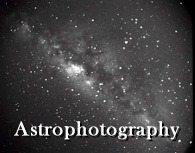|
 |
Astrophotography is a very rewarding hobby, and you can get
started with some very basic equipment. Right now a revolution is occurring
in astronomy. You can buy highly sensitive CCD and CMOS cameras from your local
mall. When used in conjunction with sophisticated astronomical and digital imaging
software these modern cameras can yield results that until very recenty would only be
possible for advanced amateurs and professionals. If you own a digital camera you
have an excellent tool for a beginner. |
 |
The advantage with using a digital camera
is that it lets you you see how well your photos turned out almost immediately. This
is more convenient than having to take your roll of film in for processing and then
waiting for it to be developed. With a digital camera you can take a dozen shots,
view them in the camera, or on a computer, and be out again under the sky to test
something different in a very short time.
Please don't buy a digital camera for astrophotography
until you have researched the matter very thoroughly. This is important because some
cameras are a LOT more sensitive than others, and for astrophotography buying the right
camera is very important. You should search the internet and ask around for
recommendations on the best camera.
At the moment many astrophotographers consider the Canon
DSLR cameras to be excellent value for money (350D, 450D, 20Da, 30D, 40D,etc.).
They're not cheap but the results are spectacular. I use a 350D which is getting a
bit old now but it is still a great camera. You could maybe pick one up secondhand
from a reputable dealer.
A sensitive low-cost video camera with a fast (f/2 or
faster) lens is a good alternative for a beginner. You can buy a
"C-mount" adapter to attach a fast (f/2 or lower) SLR camera lens, which will
let you view the night sky live on TV. I've used the Mintron 13V1 for this purpose
and I was staggered by the result. The Mintron camera cost me about $US 250 and the
adapter $US 40.
A 35 mm film camera - one with the "B" (bulb)
option for long exposures - is still a powerful tool and must not to be
underestimated. For sensitivity, and quality of image, long exposure film
photographs still rival digital photography - but this is rapidly changing. Digital
cameras are available now that yield similar results to film. In the meantime though
if you're on a limited budget consider getting a good condition second-hand 35 mm film
camera with a 50mm f/2 or faster SLR lens.
Perhaps the fastest and cheapest way to test the waters
is to use your existing camera (if you have one) on a tripod or a barn door mount.
|

